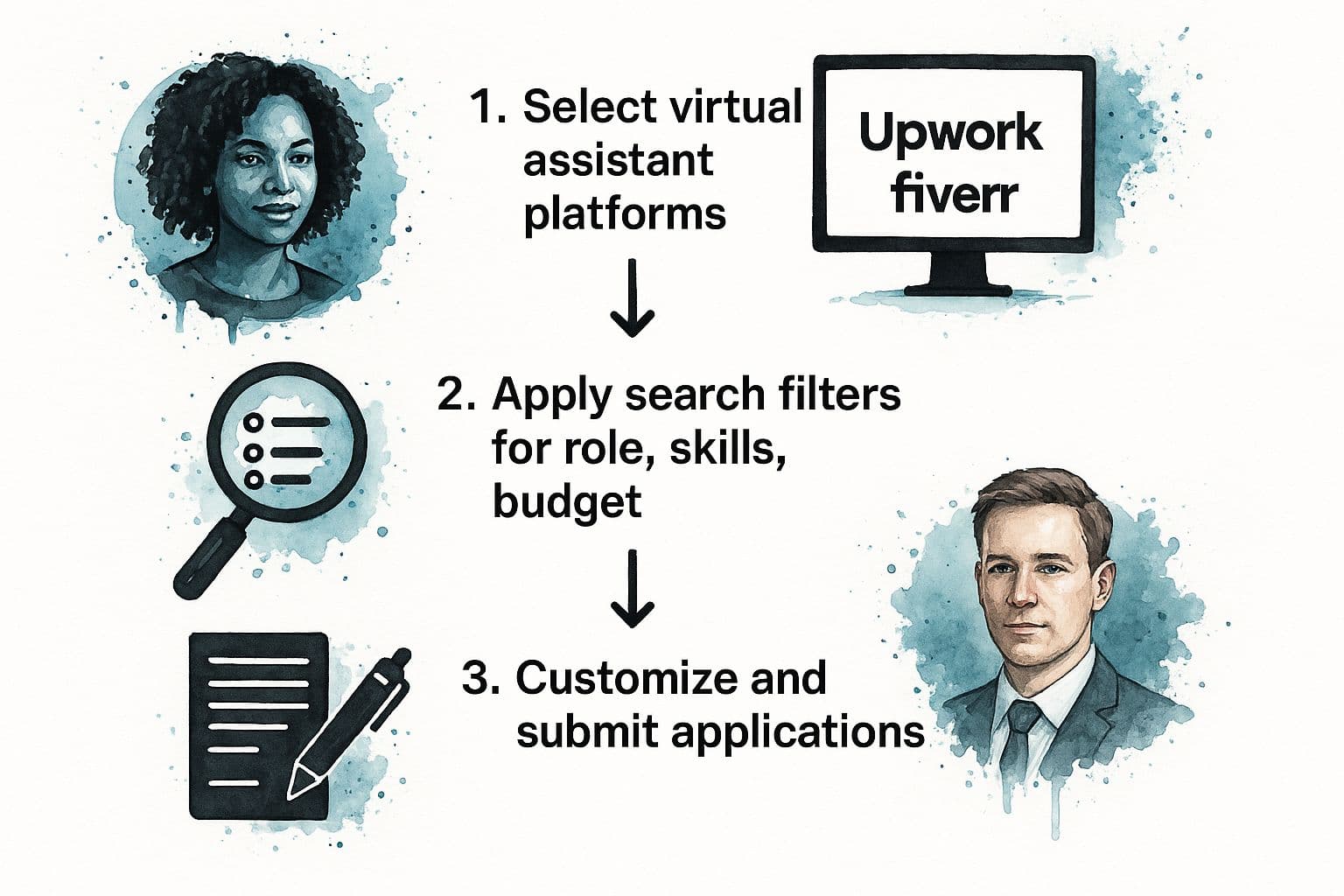Learn how to find virtual assistant jobs with proven strategies to land remote VA roles and start your freelance career today.
Do less, be more with Fluidwave
Fluidwave combines smart task prioritization with an assistant marketplace — AI and human help, all in one productivity app.
September 19, 2025 (2mo ago)
How to Find Virtual Assistant Jobs: Your Ultimate Guide
Learn how to find virtual assistant jobs with proven strategies to land remote VA roles and start your freelance career today.
← Back to blog
Figuring out how to find your first or next virtual assistant job is really about understanding the market. It’s less about just blasting out applications and more about having a smart game plan: knowing which skills are hot, building an online profile that actually gets noticed, and searching strategically on both the big job boards and VA-specific sites.
Honestly, you should treat your job search like it's your very first client project. The more you market your own skills, the better your results will be.
Understanding the Modern VA Job Market

Before you even think about applying, just take a minute to get a feel for what the virtual assistant world looks like today. The demand for VAs has absolutely blown up, and the role has gone way beyond basic admin tasks. Nowadays, everyone from solo entrepreneurs to huge companies relies on remote assistants for really important business functions.
This huge shift is mostly thanks to the move to remote work and the simple business logic of getting specialized help without the overhead of a full-time employee. The numbers are pretty wild: the global VA market is on track to hit $19.5 billion in 2025** and is expected to shoot up to $55.4 billion by 2035. A massive piece of that—almost 45%—is coming from small and medium-sized businesses.
High-Demand Industries and Skills
So, where should you even be looking? Some industries are hiring VAs way more than others. Focusing your search on these high-growth areas can give you a serious leg up.
- Tech and SaaS: These companies are always looking for VAs for customer support, helping new users get started, and keeping technical documents organized.
- E-commerce: Online store owners are constantly hunting for help with product listings, handling customer questions, and managing their orders.
- Real Estate: Agents lean on VAs to manage their calendars, keep their CRM system updated, and help market their properties.
- Digital Marketing: Agencies often hand off social media management, content creation, and running email campaigns to skilled VAs.
The most successful virtual assistants I've ever known don't try to be a jack-of-all-trades. They specialize. When you focus on a specific industry or a handful of high-value skills, you're not just another pair of hands—you're an expert.
Knowing which skills are in demand is half the battle. To really get an advantage, it helps to think like a potential client. Understanding what business owners are actually looking for when they hire can make your profile and proposals pop. To get that inside scoop, you might find it helpful to read a guide on https://fluidwave.com/blog/how-to-hire-virtual-assistant to see what drives their decisions.
Building a Profile That Attracts Great Clients

Your online profile is basically your digital storefront. It's the first thing a potential client sees on Upwork, LinkedIn, or your personal website, long before you ever send a single message. A generic profile that just says "I can do anything" is a surefire way to get ignored. It doesn't speak to anyone.
The single biggest thing you can do is switch from being a generalist to a specialist. Stop offering vague "admin support" and start carving out a specific, profitable niche. This lets you focus your whole message on solving a particular client's biggest headaches.
Pinpoint Your Profitable Niche
What industries do you already have some experience in? What skills are always in high demand? Your goal here is to become the obvious, go-to person for a specific type of client.
Here are a few real-world examples to get your brain working:
- Podcast Support for Entrepreneurs: You could handle everything from editing audio and writing show notes to booking guest appearances.
- E-commerce Admin for Shopify Stores: Focus on the nitty-gritty, like managing product listings, handling customer service emails, and keeping inventory updated.
- Executive Support for Tech Startups: Specialize in the fast-paced world of startups by managing crazy calendars, booking international travel, and designing sharp presentations.
This specialized approach does more than just help you stand out—it lets you charge higher rates. You're no longer just an assistant; you're a strategic partner who actually gets their client's business. If you're just starting out, our full guide on how to become a virtual assistant can help you build that initial foundation.
A great profile doesn't just list your skills—it solves a client's problem before they even hire you. Frame your bio around the challenges your ideal client is facing and position your services as the clear solution.
Craft a Compelling Bio and Portfolio
Your bio needs to talk directly to your target client. If you're going after real estate agents, your profile should be all about managing CRMs and scheduling property viewings. Ditch the buzzwords and focus on the real results you can deliver.
For example, instead of saying you're "organized and detail-oriented," try something like, "I help busy real estate agents save 10+ hours a week by streamlining their client follow-up process." See the difference?
A huge piece of this puzzle is optimizing your LinkedIn profile. So many VAs skip this, but it can be a total magnet for high-quality leads.
But what if you don't have experience yet? Build a portfolio with "spec" (speculative) projects. You could design a sample social media calendar for a made-up brand or create a mock travel itinerary for a multi-city business trip. This gives clients real proof of what you can do, even if you haven't been paid for it before.
Where to Find the Best Virtual Assistant Jobs
Finding good virtual assistant jobs is all about knowing where to look. Honestly, this is half the battle. Your strategy needs to be better than just browsing a single website—it's about figuring out which platforms attract the kinds of clients you actually want to work with.
Most VAs start on the big freelance marketplaces like Upwork or Fiverr. These sites are huge, and the sheer number of opportunities can be overwhelming. The downside? They're also super competitive. To succeed, you have to get really good at filtering out the low-paying gigs and niching down your profile. This is what separates the pros from the crowd of generalists.
Freelance Marketplaces vs. Niche Job Boards
While the big platforms offer a ton of jobs, you can often find better quality on VA-specific job boards. These smaller, more focused sites tend to have pre-vetted opportunities. Why? Because the clients posting there are looking for serious, professional virtual assistants, not just the cheapest help they can find.
The demand for VAs is crazy. The industry is on track to hit $25.63 billion by 2025, and you'll find around 25,000 freelancers on the major platforms who call themselves virtual assistants. This tells you two things: the demand is huge, and you need a solid strategy to stand out.
This visual breaks down a smart way to approach your job search.

As you can see, a methodical approach—picking the right platforms, using smart filters, and tailoring every single application—beats randomly firing off proposals every single time.
To help you decide where to put your energy, here’s a quick comparison of the most popular platforms for finding VA work.
Comparing Top Platforms for Virtual Assistant Jobs
| Platform | Best For | Typical Pay Structure | Key Pro | Key Con |
|---|---|---|---|---|
| Upwork | A huge variety of projects, from small one-off tasks to long-term contracts. | Hourly or fixed-price | Massive volume of job postings | Extremely competitive; platform fees can be high (up to 20%) |
| Fiverr | VAs who specialize in package-based services (e.g., "5 hours of social media management"). | Project-based "gigs" | You set your own prices and packages, which attracts clients to you. | Can be a "race to the bottom" on price if you're not positioned well. |
| High-quality, long-term roles with established businesses and executives. | Retainers or salaried positions | Access to decision-makers and unlisted "hidden" jobs. | Requires consistent networking and building your personal brand. | |
| Niche VA Boards | Specialized roles (e.g., for real estate, legal, or medical VAs). | Often hourly or retainer | Higher-quality, pre-vetted clients. | Fewer total job postings compared to the big marketplaces. |
Ultimately, a mix-and-match strategy usually works best. You might land a few small projects on Upwork to build your portfolio while you network on LinkedIn for that perfect long-term client.
Leveraging Professional Networks and Direct Outreach
Don't ignore professional networks like LinkedIn. It's an absolute goldmine for high-quality VA jobs. In my experience, a lot of the best jobs are never even publicly posted. They get filled through networking and direct connections. Start engaging with content in your niche, connect with potential clients, and consistently show up as an expert.
Another powerful—and seriously underused—tactic is direct outreach. Pick a handful of companies you would genuinely love to work for and send a personalized inquiry. It doesn't matter if they have a job advertised. Show them how you can add value. For a curated list of current openings from different sources, you can also check out dedicated pages for remote virtual assistant jobs.
Crafting Proposals That Get You Hired

Okay, you've found the perfect VA job posting. Now for the most important part: your proposal. This single document is what separates you from dozens of other applicants, and frankly, it's where most people mess up.
The fastest way to get your application deleted? Sending a generic, copy-pasted proposal. Clients can spot them from a mile away, and it just shows you didn't care enough to actually read their post. A great proposal is a direct answer to their specific problems.
So, before you type a single word, really break down that job description. Read it, then read it again. What's the real problem they're trying to solve? Are they drowning in emails? Is their social media a ghost town? Zero in on their pain point.
Frame Yourself as the Solution
Your proposal isn't a resume; it's a solution. Don't just list off your skills. You need to connect those skills directly to what the client needs. Show them you understand their world and can make an immediate difference.
Here's a simple before-and-after:
- Don't say: "I have experience with calendar management."
- Instead, try: "I saw you need help coordinating team schedules. I can jump in to manage your calendar, get rid of booking conflicts, and save you at least 5 hours of administrative headaches each week."
See the difference? The second one isn't about you; it's about them. It shows you've thought about their specific problem and already have a plan to deliver value.
The best proposals make the client feel understood. When they read your application and think, "Finally, someone who gets it," you've already won half the battle. This personalized approach dramatically increases your response rate.
Price Your Value with Confidence
Setting your rates is often the most stressful part, but you have to be confident here. Undercharging is a common mistake, and it can accidentally signal that you're inexperienced or don't value your own work.
Do your homework. Research what others are charging for the services you offer and set a price that reflects the value and expertise you bring to the table. Offering tiered service packages can also be a smart move, making it easy for clients to see what they get and choose the best fit for them.
If you're stuck on what to charge, our in-depth guide on setting competitive virtual assistant rates is a great place to start. It will walk you through how to structure your pricing so you get paid what you're actually worth.
Go Get the Good Gigs with Direct Outreach
Let's be real: the best virtual assistant jobs often never even make it to the job boards. They're filled through word-of-mouth, networking, and someone proactively reaching out before a job description is even written. If you're only reacting to job postings, you're missing out on the best opportunities. It's time to start creating your own.
This isn't about spamming people's inboxes with cold emails. It's about strategically building your reputation and making real connections. LinkedIn is your best friend here. Find the decision-makers at companies you genuinely admire—founders, execs, department heads—and start interacting with their posts. Don't just "like" them; leave thoughtful comments that show you understand their industry and the problems they're trying to solve.
Pinpointing the Right Companies
Don't waste your time with a spray-and-pray approach. You need to be selective. Look for businesses that not only fit with your skills but are also showing clear signs of growth. For instance, a startup that just announced a new round of funding or a small business launching a new product line is almost definitely stretched thin and could use your help.
Here’s how to find them:
- Keep an eye on industry news. See who’s making moves and getting attention in your niche.
- Get smart with LinkedIn. You can use tools like Sales Navigator to filter companies by size, industry, or recent growth.
- Look for the subtle clues. Is a founder super active on social media, but their company's blog hasn't been updated in months? That’s a gap you can fill.
This targeted approach makes your outreach feel relevant and valuable. It's a completely different game from the mass outsourcing trend that has defined a lot of the global VA market. We saw a huge 41% spike in VA hires back in 2020 as companies looked to cut costs by going offshore. Places like the Philippines became massive hubs for this.
While that model has its place, your strategy is about positioning yourself as a specialized, high-impact partner, not just a pair of hands. You can dig into these virtual assistant statistics to get a better feel for the market dynamics.
Writing a Cold Email That Actually Gets Read
Your email has one job: to get a reply. It needs to be short, personal, and all about them. Forget the long introduction about who you are and what you do.
Lead with a sharp observation about their business and a super clear idea of how you could add value.
Your goal isn't to land the job in that first email. It's just to start a conversation. A great cold email makes the recipient think, "Huh, this person gets it. They might be able to help."
Wrap it up with a simple, low-pressure call to action. Something like, "Would you be open to a quick 15-minute chat next week?" makes it incredibly easy for them to say yes and gets the ball rolling.
Your Top Questions About VA Jobs, Answered
Jumping into the world of virtual assistants brings up a ton of questions. That's totally normal. Getting some clear answers is the best way to build your confidence and figure out your next steps. Let’s tackle some of the most common questions I hear from VAs who are just starting out.
What Can I Realistically Earn as a Beginner?
This is the big one, right? Your starting rate really depends on your location, the niche you choose, and the skills you have.
For general administrative tasks, a new VA in the U.S. can reasonably expect to start somewhere in the $20 to $30 per hour range. That's a solid starting point.
But if you have specialized skills, don't sell yourself short. If you're comfortable with digital marketing support, executive-level assistance, or more technical tasks, you can confidently aim for $35 to $50+ per hour right from the start. The key is to know the market rate for your specific niche and have a portfolio that backs up your asking price.
Do I Absolutely Need a Certification?
Honestly, no. There's no universal "virtual assistant" certificate that clients are looking for. What they really care about is your experience, your proven skills, and a professional portfolio that shows them what you can do.
That being said, certain certifications can definitely give you an edge.
- Software-Specific Certs: Getting certified in tools like Asana, QuickBooks, or HubSpot shows a client you won't need your hand held.
- Skill-Based Certs: A certification in project management or copywriting can make your profile stand out and help justify a higher rate.
My take? A strong portfolio will always beat a generic VA certification when you're starting out. But for established VAs, a specialized cert is a smart investment to land those premium clients.
How Can I Build a Portfolio with Zero Experience?
Ah, the classic "can't get a job without experience, can't get experience without a job" problem. It feels like a dead end, but it's easier to get around than you think. You don't need paid clients to build a portfolio—you just need to create projects that prove you have the skills.
Think of it as "spec" (speculative) work. If you want to be a social media VA, create a sample one-month content calendar for a brand you love. Aspiring to be an admin VA? Draft a professional presentation or a detailed travel itinerary for a hypothetical executive. Another great strategy is to offer your services to a local non-profit for a small project; you get real-world experience and a glowing testimonial for your portfolio.
Keeping track of your job hunt, spec projects, and eventual client work can feel like a full-time job in itself. A tool like Fluidwave can be a lifesaver, giving you one central place to organize your tasks. You can even find paid gigs on the platform by assisting other users. It’s a great way to take control of your workflow and start building your VA career.
Do less, be more with Fluidwave
Fluidwave combines smart task prioritization with an assistant marketplace — AI and human help, all in one productivity app.